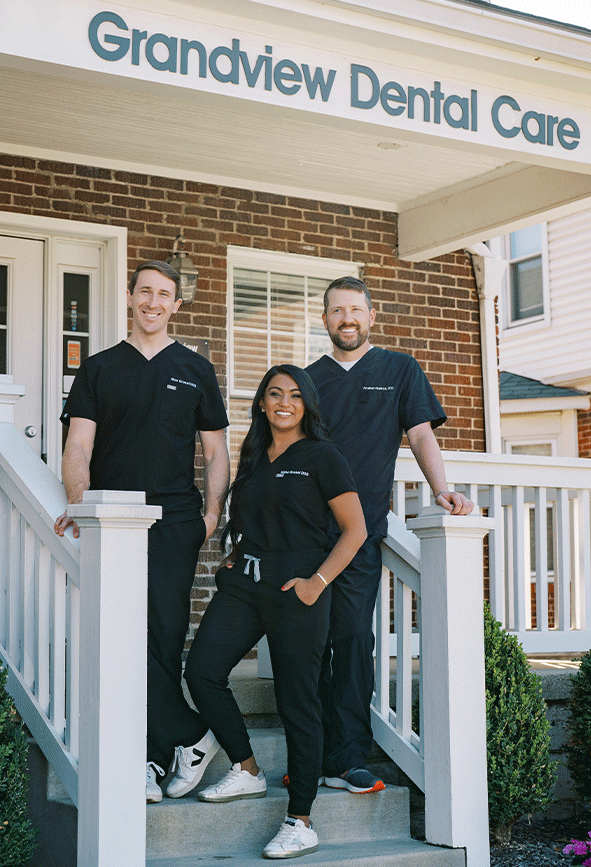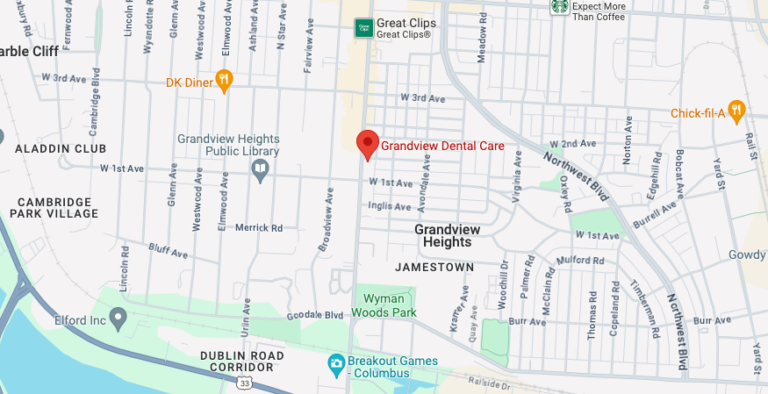Accepting
New Patients
We are currently accepting new patients at Grandview Dental Care! We offer expert dental care to communities including Grandview, Upper Arlington, Short North, Hilliard, and the surrounding Columbus areas. Schedule an appointment today!
Schedule OnlineQuality Dental Plan
Ensuring the well-being of your dental health is a significant priority for us. That's why we provide a cost-effective in-house Quality Dental Plan (QDP) that offers substantial discounts on treatment. To discover further details about our QDP, kindly follow the link provided below.
Quality Dental PlanIV Sedation Dentistry
At Grandview Dental Care, we utilize IV sedation dentistry to put you into a deep sleep, allowing you to feel completely relaxed and free of anxiety throughout your procedure. This option is great for those who have a high level of dental anxiety and/or a complex dental procedure.
IV Sedation DentistryYour Wellness is Our Priority.
Welcome to Grandview Dental Care, where your smile is our top priority. Located in the heart of Grandview Heights, our practice serves patients from Grandview, Upper Arlington, Short North, Hilliard, and the surrounding Columbus areas. At Grandview Dental Care, we pride ourselves on providing a relaxed, modern, and clean environment where patients feel welcomed and cared for from the moment they walk through our doors. Our team of experienced professionals is dedicated to ensuring your dental experience is comfortable and stress-free. Whether you’re due for a routine check-up or seeking advanced dental treatments, our skilled Columbus, Ohio dentists are here to meet your needs with personalized care and attention to detail. Discover the difference at Grandview Dental Care – your trusted partner in achieving optimal oral health and a radiant smile. Schedule your appointment today and experience dentistry reimagined.
Learn More About Grandview Dental Care
Insurance Providers
Our office is in-network with Delta Premier, but we accept most major providers. If you have any questions about your provider, give us a call, and we'd be happy to check your coverage. We can also file and track your claims to ensure you're getting the most out of your benefits. We just ask that you bring your insurance card to each appointment so we can make sure your information is as up-to-date as possible.
Alternative Payment Options
At Grandview Dental Care, we recognize the significance of affordable dental. That’s why we’re committed to delivering top-tier dental services that make both you and your wallet happy. We firmly believe everyone should have access to the dental care they need, which is why we provide financing solutions tailored to fit any budget. For those without dental insurance, our membership plan, the Quality Dental Plan, offers a solution. We are also partnered with CareCredit as a third-party lending service, so you can create a payment plan that works for you. Your oral health and financial stability are equally prioritized here, and we’re dedicated to guiding you through the process every step of the way.
External Payment Plans Quality Dental PlanExpert Dentistry.
Personalized Care.
At Grandview Dental Care, we believe that modern dental procedures and equipment can have a dramatic impact on the outcome of your smile. We utilize the latest dental technologies to provide our patients with the most up-to-date treatments available. We also recognize the importance of listening to our patients and helping them choose the best treatment option to fit their needs. While we offer a wide variety of dental services, we specialize in IV sedation dentistry, wisdom teeth removal, clear aligners, same-day crowns, and dental implants. Regardless of the treatment, our commitment to excellence and our passion for improving the health and beauty of your smile is what sets us apart.
-
IV Sedation Dentistry
We use advanced sedation dentistry for a wide variety of in-house services. Our goal is to ensure you are comfortable, calm and relaxed through any dental treatment or dental procedure. Our team will work closely with you to assess what fears you may have and determine a treatment option that feels comfortable for you.
IV Sedation Dentistry -
Wisdom Teeth Removal
Wisdom teeth are the third molars in the very back of your mouth. They don’t always need to be removed, but they can cause problems if they are not growing in properly. We provide advanced state-of-the-art oral surgery and wisdom teeth removal.
Wisdom Teeth Removal -
Clear Aligners
Clear aligners prove that effective orthodontic treatment doesn’t have to be difficult. These ingenious appliances have helped millions straighten their teeth and achieve better-looking smiles, and they can help you too.
Clear Aligners -
Same-Day Crowns
Getting a crown used to mean plastic temporary crowns and multiple visits to the dentist. Today’s approach is faster, easier, and more effective. Get your tooth fixed and receive your permanent and nearly undetectable crown all in one day.
Same-Day Crowns -
Dental Implants
Dental implants are a very reliable source for effective tooth replacement. Whether you have lost one tooth or many, implants can provide a permanent solution that looks and functions normally.
Dental Implants
Grandview Dental Care is the only dental office I have been to that makes me feel comfortable. I used to DREAD going to the dentist even for simply cleanings. They've got up to date tech, and have actually helped me to no longer get loads of cavities. The staff there are incredibly nice! Liz is the BEST hygienist I have ever had. She is gentle, kind, and so fun and easy to talk to! I will continue to tell everyone I know looking for a dentist that Grandview Dental is THE PLACE if you don't want to hate the dentist anymore.
- Briana G.
It’s always a pleasant experience to go to Grandview Dental Care. The receptionists are friendly and helpful and the hygienists do a fantastic job. I love the TV screens they have showing what the staff has been up to recently and pop quiz questions. Highly recommend if you’re looking for a dentist! Very community focused.
- Caitlin B.
Everyone at this practice is so kind and welcoming! Every person I interacted with had such a warming presence. I had the pleasure of seeing Dr. Max who was very attentive and knowledgeable. Truly one of the best dental experiences I have had!
- Clarence P.
Fantastic, wonderful, fabulous. All the good adjectives. Love this place, have been coming for about 2 years now and me and my children have been very impressed. Josie was wonderful and Dr. Nisha was wonderful as well. Very thankful to have found them.
- Greg M.
Dr. Max and Laney were awesome. They made me feel very comfortable during my procedure. My husband and I are very pleased with our choice to become part of the Grandview Dental family. They are so friendly, caring, and professional!









